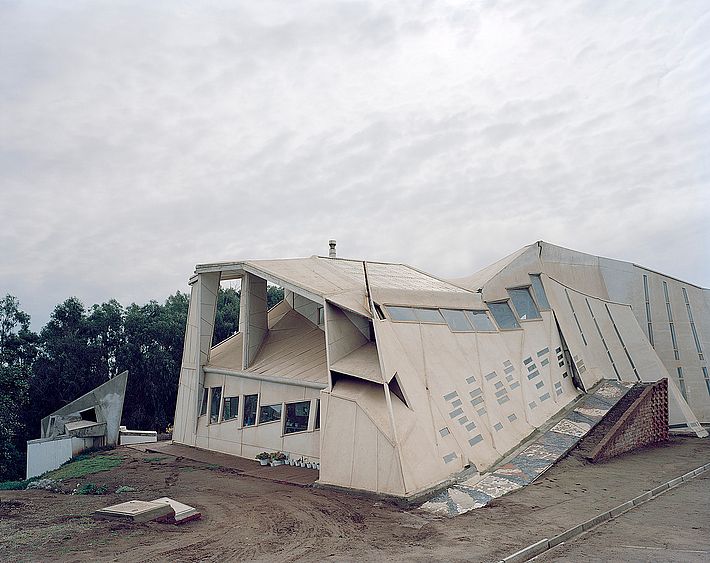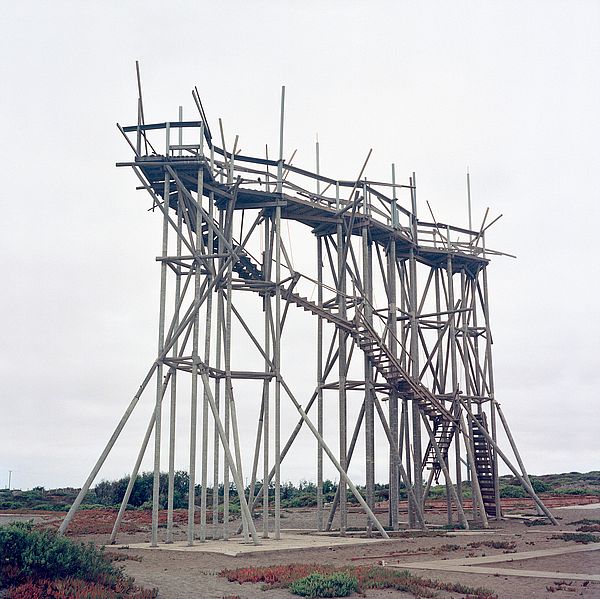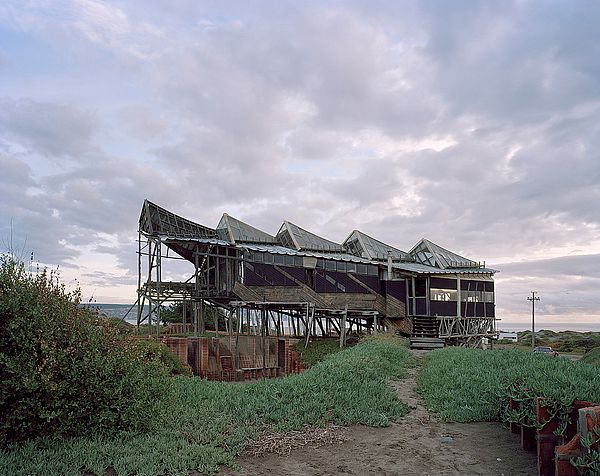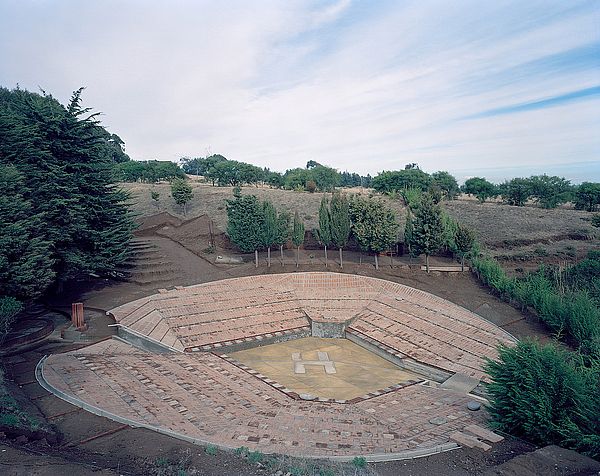From Workshops to Hackerspaces
Anja Groten about structures of innovation
Replacing classrooms with workshops is one of the Bauhaus’s best-known innovations. A hundred years later, the “workshop” is an indispensable component of all design education. But where are the limits and opportunities of this format, and what role does the realization of collective structures play in the further development of new technologies?

About Anja
Anja Groten (Amsterdam) is a designer and researcher, and co-founder of the initiative Hackers & Designers. She investigates the possibilities of frictional encounters as part of a design practice.
Absatz 1
With the increasing complexity and ubiquity of technology comes an unpredictability of its societal impacts. Not knowing how algorithms are written yet being confronted with them on a daily basis, through targeted advertisements and individualized newsfeeds, creates polarized belief systems, and myth-making about smart technology helping us build a better future or destroying humankind all together. Initiatives such as the maker movement promise to educate users to become makers. The maker movement stands for a critical attitude towards technology, and learning by doing. Community-organized workspaces where people with an interest in programming, electronics, and digital fabrication meet and work such as maker spaces and Fab Labs, offer the layperson access to hardware, software, and biotechnology without being an expert. As it goes with many good ideas, the concept of the maker space empowering individuals to create their own devices has been heavily appropriated by commercial companies. The promise of creating critical and simultaneously generative conditions for designing technology slowly shifts towards innovating and inventing the next marketable product. On the other hand, an increasing number of bottom-up hacker communities are forming that address questions such as: “Who gets to design technology?” These communities manifest on the grounds of a shared urgency to dismantle technological innovation and put forward collective making as an investigative practice.
[Translate to English:] Absatz 2
One of those communities is the Amsterdam-based collective Hackers & Designers (H&D). As a founding member, I have been investigating collective processes of designing technology. H&D initiates and hosts coding and design workshops, putting forth experiments in hacking and (self-)education. Many similar initiatives in the Netherlands started organising extra-curricular bottom-up activities outside the institutional context, fundamentally rethinking the learning structures and spaces. The initiative of H&D specifically aims to bring artists, designers, and technologists together by means of hands-on workshops. Since the first H&D meet-up in 2013, activities have dealt with matters such as web and network technology, cryptography, and computational automation processes, such as machine learning.

Absatz 3 und 4
The co-creative and cross-disciplinary design approach to making, as exercised by H&D, is not new. At the Bauhaus, the workshop already functioned as the central place where “art and technology were brought together as a ‘new unity’ to meet the design challenges of the period” (Kentgens-Craig, 1998). Equally, this hands-on approach to producing knowledge, paired with a strong sense of collectivity, is an effective way of learning about technology. Touching, soldering, breaking apart, and deploying code are means of acquiring new knowledge and skills, while simultaneously confronting the assumptions, dogmas, and enchantments of dominant technological constructions.
The notion of the workshop referred to in this article does not directly refer to the original meaning of the artisan workshop; however, there is still a level of skill and competency that is shared among workshop participants. Drawing on my own work as a designer and my experience in working with H&D, this article attempts to unravel the phenomenon of the workshop and discuss the limitations and possibilities of this format for learning and unlearning about our reliance on technology, and our assumptions and omissions inhabited by those technologies.
From workshops to workshopping
The workshop has popularized as a format for collaboration and cultural production. Buzzwords surrounding the workshop phenomenon such as “rapid prototyping” promote high-velocity technological development paint the workshop as a highly productive format. Situated between work and leisure, workshops are usually organized in the context of extra-curricular activities, such as symposia, incubator programs, and innovation labs.
I taught a practice seminar about co-creation in 2017–2018 at the design department of the Sandberg Instituut in Amsterdam. One of the students of this seminar asked: “Why does everything have to be a workshop these days?” Having just undergone an entire semester of weekly hands-on workshops, this question most probably came from a certain exhaustion with this format. However, the question also addresses a certain exhaustion of the “workshop market,” a workshopisation of cultural production, and a general disappointment in what a workshop can actually achieve. Workshopping has become a popular mode for cultural production, offering a framework for social gatherings, and producing and sharing knowledge. Yet there seems to be a lack of specificity in articulating the premise of the workshop format, as well as its characteristics and objectives. The absence of a standardized definition of the term workshop might be an indication for the divergence of conceptions and expectations about the limits and possibilities of the workshop format. However, distinctions can be made by looking at branches and deviations of the workshop.

Absatz 6
One of these branches, affiliated with technology design, is the hackathon, a format effectively utilizing the “hybrid state of performing labour and leisure” (Lodato and DiSalvo, 2016). The hackathon draws on hands-on iterative prototyping and usually focuses on a specific technology or programming language. Another workshop branch is the participatory design workshop, which is referred to as cooperative design—initially described a user-centered research approach, including workers involved in the processes of implementing new technology in the work environment in Norway in the 1970s.
Absatz 7
The participatory design workshop has become a secret weapon for socially engaged designers working in the fields of urban planning, architectural design, and software development. Participatory design practices counter a detached design approach by letting the end-users take part in the design process, rather than approaching them as distant target groups or consumers. The workshop format offers an investigative environment and an opportunity to introduce all stakeholders to the design process in a co-productive manner. In most cases, “the designers’ status as expert confers greater authority in decision-making than laypersons” (Hirsch, 2008). There are also examples of participatory or user-centered design workshops that succeed in democratizing design processes and empowering individuals to exercise control over their environment. However, oftentimes participatory design work- shops run the risk of limiting a layperson’s participation to a “passive role”, such as filling out surveys or joining a focus group. Both these formats exemplify a dilemma of workshops I frequently come across. There is a general notion of the workshop being a highly productive space. However, workshops are often only considered successful if a tangible result has been produced: a product or prototype that can be presented to a wider audience. The hackathon and the participatory-design workshop share a problem-solving approach to making, and therefore miss out on crucial qualities of experimentation, for instance the possibility of failure. Such result-driven working conditions for making disregard the possibility for problem setting, and contingent insights that arise when producing disposals rather than proposals.
Why does everything have to be a workshop these days?
Anja Groten
Absatz 8
In his talk at [MAKE] AIGA Design Educators Conference 2018 in Indianapolis, Matt Ratto described one of his critical making seminars. “Critical making is a term coined by Matt Ratto describing work that combines humanities insights and engineering practices” (Ratto, 2017). In his seminar, students are aware from the outset that they will have to destroy their prototypes once the seminar is complete. It is therefore clear that whatever is made is not regarded as precious. This allowed students to let go of any pressure to produce functional or aesthetically pleasing artefacts. Instead they were able to consider the potentialities and boundaries of the collaborative making process.
User or maker?
Designers and software developers could be regarded as users as much as makers. Relying on a multiplicity of tools and devices myself confronts me with the pressing question: as makers, how far are we actually capable of participating in the work we create? In the words of the Critical Engineers: if “each work of engineering engineers its user, proportional to that user’s dependency upon it,” (Critical Engineering Working Group, 2011) how much can we obtain control over what we design? If the common range of tools are proprietary black boxes that persuade with “intuitive” smooth interfaces, one update-click away from being incompatible with whatever hardware we are using, how can we develop and maintain self-determined practices?
The Graphic User Interface (GUI), as designed by a group of engineers in Xerox PARC in the 1970s, and specifically by Alan Kay, was a generous invention with an intention of empowering computer users. Alan Kay looked at the computer as a tool to create tools, and users as the makers of their own tools. “The ability to ‘read’ a medium means you can access materiality and tools generated by others. The ability to ‘write’ in a medium means you can generate materials and tools for others. You must have both to be literate” (Manovich, 2013).

Absatz 11
Brave designers and design students find an answer in Free/Libre Open Source Software (FLOSS), running their own scripts and integrating self-made plugins. The advantage of FLOSS is the accessibility of the source code, which may be copied and appropriated. Due to its open and co-creative character, open source offers far-reaching possibilities for the realm of art and design education. They are uncomfortable and unfamiliar, and spaces of discomfort are usually those where learning takes place. Witnessing tutors and students patiently pondering over their error messages and fixing their bugs had a big impact on both my understanding of and approach to programming, and opened up a whole new range of possibilities in terms of the tools I use, build, and hack.
Facing and countering habits
In his book “Educating the Reflective Practitioner” Donald A. Schön talks about the sequence of skilful judgements, decisions, and actions a maker undertakes spontaneously, without con- scious deliberation, a process he terms “knowing-in-action”. Makers have learned how to do something skilfully and smoothly. They are able to do things “without thinking,” so to speak, drawing on their tacit knowledge (Schön, 1988). I observe those skills becoming publicly discernable during workshop situations. While co-creating—partaking in each other’s ways of doing—habitual methods and skills suddenly become the subject of attention and questioning. The making process, which is familiar to one individual, might fail to meet another person’s expectations of how “things are done.” That disruption can be pleasantly surprising, or unpleasantly disturbing.
[Translate to English:] Absatz 12 – 13
Schön calls this surprise effect of errors and disruption while executing a skill “reflection-in-action”. Although Schön talks about the individual maker, I would argue that this spontaneous reflection-in-action also takes place during collective making processes. The makers involved in the process do not solely reflect on something in the past. Reflection can instead happen while something is being produced, and therefore has immediate consequences. Collective interaction constantly influences the thing that is being made. It is shaped and reshaped by contingent disruptions. Those frictions result from the interplay of people’s interactions during a collective making situation, alongside their interactions with the piece of technology that is being made, and the technology that is used to make it.
Encounters with making
Shifting the focus away from designed objects and towards the process of prototyping allows for developing a collective understanding of the inner workings of the proposed technology, conditions, and implications the technology has been affected by and will affect. Thomas Lodato and Carl DiSalvo write: “... a distinction needs to be made between the prototype and prototyping, as an activity” (Binder et al. 2012). The object is crucial, but it is a product of the social process of conceptualizing and expressing the wants and needs. The activity of prototyping, then, is dialogic in that its structure is one of exchange and its purpose is the discovery and elucidation of the conditions or factors of a design. (Lodato and DiSalvo, 2016).
Collective interaction constantly influences the thing that is being made
Anja Groten
Absatz 14
An encounter with a maker, with what is made while it is being made, is the moment in which action and therefore change can actually happen. Workshops organised by H&D—and similar workshop initiatives such as Relearn or Open Set in Belgium and the Netherlands—are organized without approaches to problem-solving. Neither do those workshops put forward an imperative of consensus, which further differentiates them from common forms of participatory-design workshops or hackathons. Discussions and disagreements about the implications of the examined technology are common. Engaging in open yet con- testing approaches to making helps bring about “a kind of socio-technical literacy that is necessary to reconnect materiality and morality” (Lodato and DiSalvo, 2016). Through exercising hands-on modes of learning and unlearning about and within technology, we can actively create space to reevaluate and calibrate perspectives on accelerated technological processes and their entanglements in society, calling into question mystifying and tech-optimist representations of innovation— what innovation is and how it is developed.
This article was originally published in the third issue of the “bauhaus now” magazine.